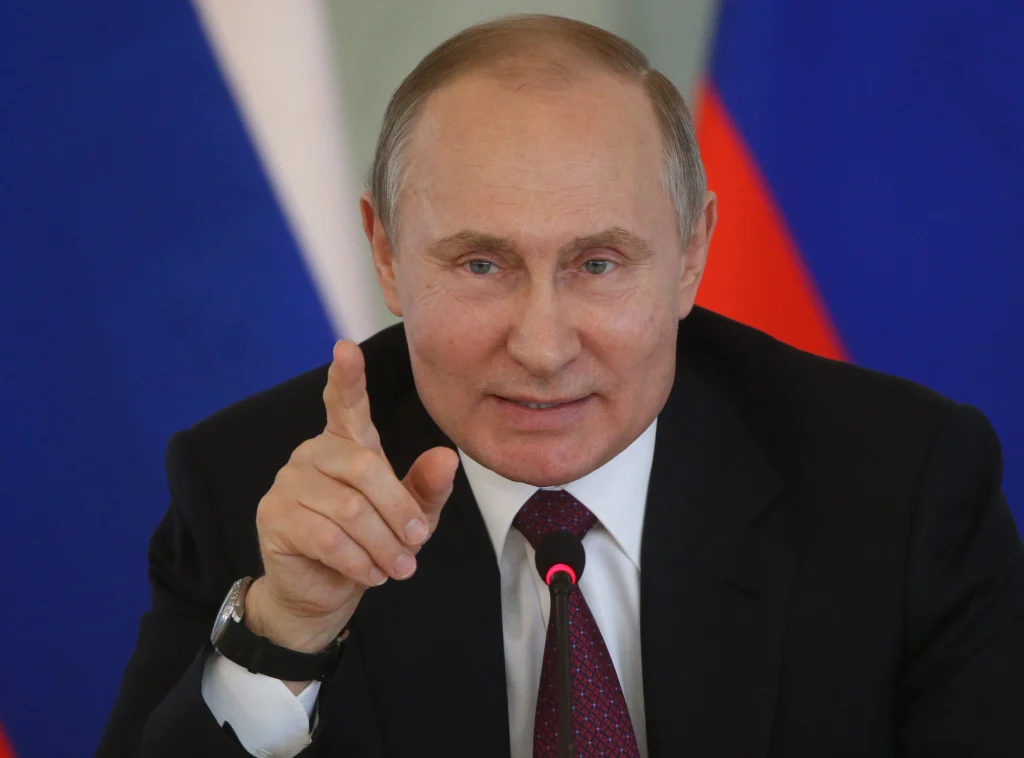
Russia’s President Vladimir Putin is widely believed to have started his invasion of Ukraine expecting a quick victory.
The war risks becoming one of “attrition” in which each side seeks to wear down the other in a potentially protracted, bloody and destructive conflict.
Russia reported on March 2 that 498 of its armed forces had been killed in the fighting but has not provided an official update since then.
As Russia’s unprovoked invasion of Ukraine drags close to a fourth week it’s becoming clear to both Moscow and Kyiv that the conflict will not be easily won, or lost, by either side.
Russian President Vladimir Putin is widely believed to have started his invasion of Ukraine expecting a quick victory, having miscalculated and underestimated the resistance Ukrainian forces and thousands of volunteer civilian fighters would mount to fight for their homeland.
So far, Russian forces have only captured one city, Kherson, while a much-feared assault on the capital Kyiv has yet to begin, the second-largest city Kharkiv continues to resist and the western city of Lviv has been relatively unscathed.
The Russian invasion has nonetheless unleashed widespread destruction on parts of the country and cities that are vital for Ukraine’s economic wellbeing, like Mariupol — a key port city for Ukraine from which it exports grain and steel among other goods — which is still under siege and heavily destroyed.
With Russia making little headway in its wider overall invasion and Ukraine battling to concede as little territory and vital infrastructure as possible, the conflict quickly risks becoming a “war of attrition,” analysts say — essentially, a prolonged struggle in which both sides seek to exhaust the opponent through the gradual loss of personnel, equipment and supplies.
“The war in Ukraine is likely heading towards a grinding war scenario — a stalemate phase during which both sides have limited ability to conduct offensive operations while the devastation and human suffering continues,” Andrius Tursa, Central and Eastern Europe advisor at Teneo Intelligence, said in a note this week.
Russia’s offensive continues to advance slowly, Tursa noted, adding that “Moscow is resorting to more brutal warfare tactics (mainly aerial, missile and artillery bombardment) targeting non-military and civilian infrastructure in order to break public morale and resistance.
This, he said, was exemplified by Russian forces appearing to be targeting food storage facilities and large shopping centers, such as a shopping mall destroyed in Kyiv on Monday, seen in this image below. The Kremlin has repeatedly denied it targets civilians.
Echoing the concerns shared by other analysts and strategists, Tursa warned an increasingly frustrated and pressurized Russian army could resort to inflicting event greater destruction to keep the campaign alive, testing the resolve of the Ukrainians and the West, which has pledged to continue supplying arms to Ukraine but has refused to intervene directly, fearing a direct confrontation with nuclear power Russia.
Losses are mounting
Ukraine’s Defense Ministry claimed on Tuesday that roughly 15,300 Russian troops have been killed since the Kremlin launched its onslaught on Feb. 24, although CNBC has not been able to independently verify these figures.
Russia reported on March 2 that 498 of its armed forces had been killed in the fighting but it has not provided an official update since then.
The pro-Kremlin Russian newspaper Komsomolskaya Pravda reported Monday, citing Russia’s Defense Ministry, that 9,861 Russian soldiers had died since the beginning of the war but it has since deleted the article after claiming it was hacked.
If the Ukrainian figures are correct, however, the number of Russian soldiers that have died is around the same number that died in Russia’s ill-fated invasion of Afghanistan in 1979, which led to an unpopular 10-year conflict.
Ian Bremmer, Eurasia Group president, said in a note Monday that, short of a Russian mass mobilization and a continuous flow of equipment and personnel to the frontline fighting — which Putin isn’t presently ordering — the coming weeks of ground fighting aren’t likely to change much for the Russians.
“The Russians are taking heavy losses from the fighting (already more than the combined U.S. military losses in 20 years of fighting in Iraq and Afghanistan), including high numbers of military leaders in the field. Capturing Kyiv isn’t a realistic option for the Russian military at present,” Bremmer said, while conversely “the Ukrainians have become more emboldened by Russian difficulties in the field and the international support for their country.”
Bremmer believed the best-case scenario for Russia was that Putin withdraws most troops and is no longer fighting an active war but noted that in the process, Russia would have lost its energy superpower status and have a crippled economy, its smartest citizens having left and its currency destroyed.
Putin is ‘desperate’
There are also concerns that Putin, with his “back against the wall” as President Joe Biden described his position on Monday, could resort to using chemical weapons in Ukraine in a bid to gain an upper hand in the conflict, no matter what the cost to human life.
For its part, Russia has said it does not target civilians and is not preparing to use chemical weapons. Russia’s Ministry of Defense has previously directed CNBC to a statement from more than two weeks ago which said in part that Russian forces carry out strikes only on military targets “using high-precision weapons.”
However, overwhelming photographic and video evidence, as well as official assessments from the U.S., U.K. and others, show that Russia is in fact striking civilian targets with unguided weapons. There has been more death and destruction this week with attacks on Mariupol continuing and thousands of Ukrainians remaining trapped there.
The besieged city is surrounded by Russian forces and water, electricity, food and medicine supplies have been running low for days, prompting questions over how long Ukrainian forces can hold the city, a key strategic goal for Russia, which aims to create a land corridor between Crimea and areas held by pro-Russian separatists in eastern Ukraine, and Russia. For Ukraine, the city is a vital export hub.
“It’s certainly an attrition conflict,” Michal Baranowski, senior fellow and director of the German Marshall Fund’s Warsaw office, told CNBC Tuesday, “but it’s not a frozen conflict by any means.”
“It’s a stalemate in which Ukrainians keep dying, that’s why the Western support is still very necessary, but in which, of course, Russia is not reaching its strategic objectives. Putin is unfortunately desperate, he’s not winning and he’s cornered and that’s why we’re all worried about the use of chemical weapons which would be a terrible escalation,” Baranowski added.
He said the main objective was to make sure the war does not escalate and that the war does come to an end, and Russia pulls out of Ukraine and that some kind of political settlement is reached between Ukraine and Russia.
How does this end?
Ukraine has attracted much admiration around the world for its brave resistance to Russia’s forces, mass shelling, siege tactics and what has widely appeared to be the targeting of civilian infrastructure, including residential buildings, hospitals and, most recently, a theater in which hundreds of people were sheltering.
Over 3.5 million people have fled Ukraine, however, and hundreds of civilians have died.
Ukrainian President Volodymyr Zelenskyy has appealed to leaders around the world, and particularly those in Europe and the U.S., to supply more arms to Ukraine and to apply more sanctions on Russia’s already heavily-sanctioned economy.
On Tuesday, Zelenskyy warned that his country was “on the brink of survival” in the war, telling the Italian Parliament in an address via video link that Russia won’t stop at Ukraine. The comments prompted some head-scratching as Zelenskyy has been upbeat about Ukraine’s chances of defeating Russia in daily updates for the public and addresses to foreign leaders, saying the country will fight to the very end.
Kurt Volker, former U.S. ambassador to NATO, told CNBC he is optimistic that Russia will be the first to stumble in the war, given the logistical challenges it faces as its invasion drags on — and it has not even begun its assault on the capital Kyiv yet — and the need for more arms and manpower.
“I think the way it ends is the Russians exhaust themselves,” Volker told CNBC on Friday. “And whether it’s Putin or whether it’s people around Putin, they’ll end up settling.”
“Ukrainians are feeling very confident and their demand is that the Russians leave their country and I think they’re going to stick to that and I don’t think Russia will be able to sustain [the invasion] once they are unable to supply their forces. So I think it continues like this for a while, and then I think it ends up favoring a Russian withdrawal,” Volker believed.




Telegram中文版 是一款注重隐私和安全的消息应用,提供端到端加密聊天等功能。